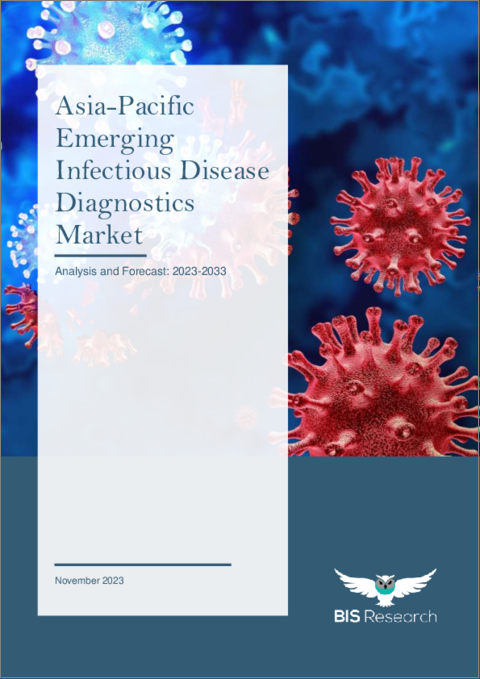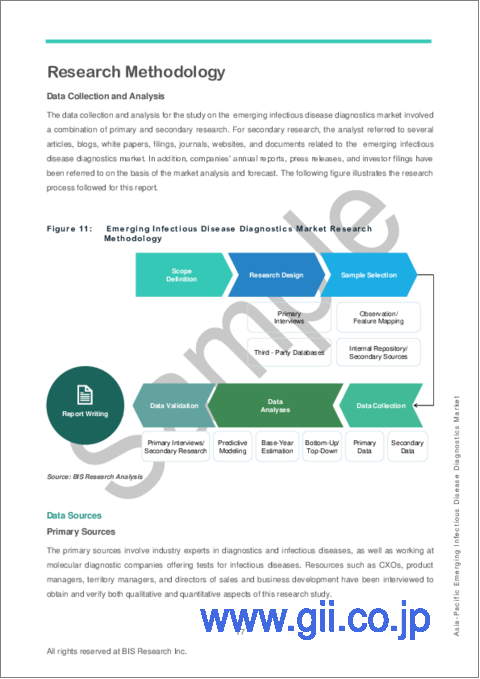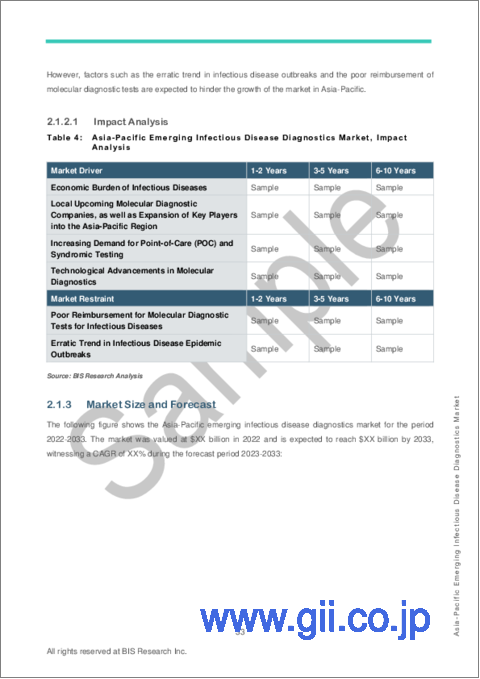|
|
市場調査レポート
商品コード
1389583
アジア太平洋の新興感染症診断市場 - 分析と予測(2023年~2033年)Asia-Pacific Emerging Infectious Disease Diagnostics Market - Analysis and Forecast, 2023-2033 |
||||||
カスタマイズ可能
|
|||||||
| アジア太平洋の新興感染症診断市場 - 分析と予測(2023年~2033年) |
|
出版日: 2023年12月01日
発行: BIS Research
ページ情報: 英文 116 Pages
納期: 1~5営業日
|
- 全表示
- 概要
- 図表
- 目次
アジア太平洋の新興感染症診断市場は、2022年に44億1,000万米ドルと評価され、2033年には108億3,000万米ドルに達すると予測されており、2023年~2033年のCAGRは8.65%になると見込まれています。
アジア太平洋における感染症診断市場の拡大を後押ししている要因は数多くあります。感染症による経済的負担、パートナーシップや融資という形での各国政府からの支援、迅速かつ徹底した検査に対する需要の高まり、分子診断技術の発展などがその一例です。
| 主要市場統計 | |
|---|---|
| 予測期間 | 2023年~2033年 |
| 2023年の評価額 | 47億3,000万米ドル |
| 2033年予測 | 108億3,000万米ドル |
| CAGR | 8.65% |
アジア太平洋市場において、感染症診断薬は、感染している可能性のある人々の感染因子を特定・発見するために使用される様々なアプローチや手順から構成されます。これらの診断薬は、迅速な治療方針の決定、正確な疾病診断、公衆衛生イニシアチブの実行に不可欠です。
微生物培養は、感染症の診断に用いられる基本的な方法のひとつです。特定の病原体を分離・同定するために、患者検体は特殊な増殖培地で培養されます。ヘルスケア専門家はこれによって原因菌を特定し、抗生物質感受性を評価することができます。
分子診断学はアジア太平洋産業における重要な戦略です。これは、核酸増幅検査(NAAT)やポリメラーゼ連鎖反応(PCR)のような方法を用いて、感染性病原体の遺伝子構成を検出することを伴う。これにより、低濃度でも高感度で特異的な病原体の同定が可能になります。
当レポートでは、アジア太平洋の新興感染症診断市場について調査し、市場の概要とともに、用途別、技術別、感染タイプ別、疾患タイプ別、エンドユーザー別、地域別の動向、および市場に参入する企業のプロファイルなどを提供しています。
目次
第1章 市場
- 市場の見通し
- 業界の展望
- 市場力学
第2章 アジア太平洋
- アジア太平洋の新興感染症診断市場
- 規制の枠組み
- 市場力学
- 市場規模と予測
第3章 市場-競合ベンチマーキングと企業プロファイル
- 競合情勢
- 概要
- 経営戦略
- 事業戦略
- 市場シェア分析
- 新興感染症診断エコシステムの活躍企業
- 企業プロファイル
- 企業概要
- CrisprBits
List of Figures
- Figure 1: History of Infectious Disease Outbreaks Globally
- Figure 2: Number of Infectious Disease Outbreaks per Year Reported by the WHO, Estimates
- Figure 3: Emerging Infectious Disease Diagnostics Market (by Technology), $Billion, 2022-2033
- Figure 4: Emerging Infectious Disease Diagnostics Market, Impact Analysis
- Figure 5: Emerging Infectious Disease Diagnostics Market (by Technology), Share (%), 2022 and 2033
- Figure 6: Emerging Infectious Disease Diagnostics Market (by Application), Share (%), 2022 and 2033
- Figure 7: Share of Key Developments, January 2019-June 2023
- Figure 8: Emerging Infectious Disease Diagnostics Market (by Region), $Billion, 2022 and 2033
- Figure 9: Market Share Analysis for Emerging Infectious Disease Diagnostics Market (by Company), 2022
- Figure 10: Key Insights Validated from Primary Interviews
- Figure 11: Emerging Infectious Disease Diagnostics Market Segmentation
- Figure 12: Emerging Infectious Disease Diagnostics Market Research Methodology
- Figure 13: Primary Research Methodology
- Figure 14: Bottom-Up Approach (Segment-Wise Analysis)
- Figure 15: Top-Down Approach (Segment-Wise Analysis)
- Figure 16: Timeline of Emerging Technologies for Infectious Disease Diagnostics
- Figure 17: Advantages of Emerging Infectious Disease Diagnostic Technologies
- Figure 18: Limitations of Emerging Infectious Disease Diagnostic Technologies
- Figure 19: Key Settings of POC Testing Deployment
- Figure 20: Key Challenges Associated with Point-of-Care Testing
- Figure 21: Emerging Infectious Disease Diagnostics Market (by Technology), $Billion, 2022-2033
- Figure 22: Future Potential of NGS in Infectious Disease Diagnostics
- Figure 23: Number of Molecular Diagnostics Patents for Infectious Diseases (by Year)
- Figure 24: Number of Molecular Diagnostic Patents for Infectious Diseases (by Country/Organization)
- Figure 25: Key Benefits of Home-Based Testing
- Figure 26: Typical Supply Chain for a Diagnostic Test
- Figure 27: Emerging Infectious Disease Diagnostics Market, Impact Analysis
- Figure 28: Fiscal Response to the COVID-19 Pandemic (% of GDP)
- Figure 29: Advantages of Point-of-Care Tests in Molecular Diagnostics
- Figure 30: Key Clinical Areas Demanding Commercial Availability of Syndromic Tests
- Figure 31: Advantages of INAAT over PCR
- Figure 32: Number of LAMP Publications on Public Databases, 2016-2022
- Figure 33: Number of INAAT Publications on Public Databases, 2016-2022
- Figure 34: Advantages of Digital PCR over Quantitative Real-Time PCR
- Figure 35: Number of "Digital PCR" Publications on Public Databases, 2016-2022
- Figure 36: Notable Outbreaks of Infectious Diseases in Humans (by Region)
- Figure 37: Number of Infectious Disease Outbreaks per Year Reported by the WHO, Estimates
- Figure 38: Asia-Pacific Emerging Infectious Disease Diagnostics Market, $Billion, 2022-2033
- Figure 39: Asia-Pacific Emerging Infectious Disease Diagnostics Market (by Application), $Billion, 2022-2033
- Figure 40: Asia-Pacific Emerging Infectious Disease Diagnostics Market (by Technology), $Billion, 2022-2033
- Figure 41: Asia-Pacific Emerging Infectious Disease Diagnostics Market (by Type of Infection), $Billion, 2022-2033
- Figure 42: Asia-Pacific Emerging Infectious Disease Diagnostics Market (by Disease Type), $Billion, 2022-2033
- Figure 43: Asia-Pacific Emerging Infectious Disease Diagnostics Market (by End User), $Billion, 2022-2033
- Figure 44: Asia-Pacific Emerging Infectious Disease Diagnostics Market (by Country), % Share, 2022 and 2033
- Figure 45: Japan Emerging Infectious Disease Diagnostics Market, $Billion, 2022-2033
- Figure 46: Japan Emerging Infectious Disease Diagnostics Market (by End User), $Billion, 2022-2033
- Figure 47: China Emerging Infectious Disease Diagnostics Market, $Billion, 2022-2033
- Figure 48: China Emerging Infectious Disease Diagnostics Market (by End User), $Billion, 2022-2033
- Figure 49: Australia Emerging Infectious Disease Diagnostics Market, $Billion, 2022-2033
- Figure 50: Australia Emerging Infectious Disease Diagnostics Market (by End User), $Million, 2022-2033
- Figure 51: South Korea Emerging Infectious Disease Diagnostics Market, $Billion, 2022-2033
- Figure 52: South Korea Emerging Infectious Disease Diagnostics Market (by End User), $Million, 2022-2033
- Figure 53: India Emerging Infectious Disease Diagnostics Market, $Billion, 2022-2033
- Figure 54: India Emerging Infectious Disease Diagnostics Market (by End User), $Million, 2022-2033
- Figure 55: Rest-of-Asia-Pacific Emerging Infectious Disease Diagnostics Market, $Billion, 2022-2033
- Figure 56: Rest-of-Asia-Pacific Emerging Infectious Disease Diagnostics Market (by End User), $Million, 2022-2033
- Figure 57: Share of Key Developments, January 2019-June 2023
- Figure 58: Number of Mergers and Acquisitions (by Company), January 2019-June 2023
- Figure 59: Share of Synergistic Activities (by Company), January 2019-June 2023
- Figure 60: Number of Business Expansions and Funding Activities (by Company), January 2019-June 2023
- Figure 61: Number of Product Launches/Upgradations/Approvals (by Company), January 2019-June 2023
- Figure 62: Market Share Analysis for Emerging Infectious Disease Diagnostics Market (by Company), 2022
- Figure 63: Emerging Infectious Disease Diagnostics Market, Total Number of Companies Profiled
- Figure 64: CrisprBits: Overall Product Portfolio
List of Tables
- Table 1: Some of the Key Developments By Companies Leveraging Emerging Technologies in Infectious Disease Diagnostics
- Table 2: Key Product Offerings by Players in the Emerging Infectious Disease Diagnostics Market
- Table 3: Key Questions Answered in the Report
- Table 4: Some of the RT-LAMP Assays Developed during COVID-19
- Table 5: Molecular Diagnostic Products for Infectious Diseases Under Development
- Table 6: At-Home COVID-19 Kits Approved for Commercial Use by ICMR
- Table 7: Disease Burden for Infectious Diseases (DALY), , Million, 2019
- Table 8: Key Initiatives by Governments Globally
- Table 9: Examples of International Research Consortiums for Managing Response to Infectious Diseases
- Table 10: List of Infectious Disease Outbreaks (by Region and Year)
- Table 11: Asia-Pacific Emerging Infectious Disease Diagnostics Market, Impact Analysis
- Table 12: Emerging Infectious Disease Diagnostics Market, Key Active Players
“The Asia-Pacific Emerging Infectious Disease Diagnostics Market Expected to Reach $10.83 Billion by 2033.”
Introduction to Asia-Pacific Emerging Infectious Disease Diagnostics Market
The Asia-Pacific emerging infectious disease diagnostics market was valued at $4.41 billion in 2022 and is expected to reach $10.83 billion by 2033, growing at a CAGR of 8.65% between 2023 and 2033. A number of factors are driving the growing infectious disease diagnostics market's expansion in the Asia-Pacific area. The financial burden of infectious diseases, support from governments in the form of partnerships and financing, the growing demand for rapid and thorough testing, and developments in molecular diagnostics technology are some of these causes.
Market Introduction
| KEY MARKET STATISTICS | |
|---|---|
| Forecast Period | 2023 - 2033 |
| 2023 Evaluation | $4.73 Billion |
| 2033 Forecast | $10.83 Billion |
| CAGR | 8.65% |
In the APAC market, diagnostics for infectious diseases comprise a variety of approaches and procedures used to identify and find infectious agents in people who may be infected. These diagnostics are essential for prompt treatment decisions, accurate disease diagnosis, and the execution of public health initiatives.
Microbiological culture is one of the basic methods used in the diagnosis of infectious diseases. To isolate and identify certain pathogens, patient specimens are cultured on specialized growth media. Healthcare professionals can identify the causing organism and evaluate its antibiotic susceptibility by doing this.
Molecular diagnostics is a key strategy in the APAC industry. This entails detecting the genetic makeup of the infectious pathogen using methods like nucleic acid amplification tests (NAATs) and polymerase chain reaction (PCR). This enables the highly sensitive and specific identification of pathogens, even at low concentrations.
Market Segmentation:
Segmentation 1: by Application
- Laboratory Testing
- Point-of-Care Testing
Segmentation 2: by Technology
- Polymerase Chain Reaction (PCR)
- Isothermal Nucleic Acid Amplification Technology (INAAT)
- Next-Generation Sequencing (NGS)
- Immunodiagnostics
- Other Technologies
Segmentation 3: by Type of Infection
- Bacterial
- Viral
- Fungal
- Other Infections
Segmentation 4: by Disease Type
- Respiratory Infections
- Sexually Transmitted Infections (STIs)
- Gastrointestinal Infections
- Other Infections
Segmentation 5: by End User
- Hospitals and Clinics
- Diagnostic Laboratories
- Other End Users
Segmentation 6: by Region
- Asia-Pacific - Japan, China, India, South Korea, Australia, Rest-of-Asia-Pacific
How Can This Report Add Value to an Organization?
Product/Innovation Strategy: The Asia-Pacific emerging infectious disease diagnostics market has been extensively segmented on the basis of various categories, such as application, technology, type of infection, disease type, end user, and region. This can help readers get a clear overview of which segments account for the largest share and which ones are well-positioned to grow in the coming years.
Competitive Strategy: The Asia-Pacific emerging infectious disease diagnostics market is fragmented, with several established as well as emerging players. Key players in the Asia-Pacific emerging infectious disease diagnostics market analyzed and profiled in the study involve established players that offer various kinds of molecular diagnostic tests for infectious diseases.
Table of Contents
1 Markets
- 1.1 Market Outlook
- 1.1.1 Product Definition
- 1.1.2 Inclusion and Exclusion Criteria
- 1.1.3 Key Findings
- 1.2 Industry Outlook
- 1.2.1 Market Overview
- 1.2.1.1 Timeline of Emerging Technologies for Infectious Disease Diagnostics
- 1.2.1.2 Advantages and Limitations of Emerging Infectious Disease Diagnostic Technologies
- 1.2.1.3 Advantages and Limitations of Point-of-Care Emerging Infectious Disease Diagnostics
- 1.2.1.4 Current Market Landscape of Emerging Infectious Disease Diagnostics
- 1.2.1.5 Future Potential
- 1.2.1.5.1 CRISPR
- 1.2.1.5.2 NGS
- 1.2.1.5.3 INAAT
- 1.2.1.5.4 Digital PCR (dPCR)
- 1.2.2 Patent Analysis
- 1.2.2.1 By Year
- 1.2.2.2 By Country/Organization
- 1.2.3 Pipeline Analysis
- 1.2.4 Impact of COVID-19 on Infectious Disease Diagnostics
- 1.2.4.1 Post-COVID-19 Scenario: A Paradigm Shift to Home-Based Testing
- 1.2.5 Supply Chain Analysis
- 1.2.1 Market Overview
- 1.3 Market Dynamics
- 1.3.1 Impact Analysis
- 1.3.2 Drivers
- 1.3.2.1 Economic Burden of Infectious Diseases
- 1.3.2.2 Government Support to Advance Research and Facilitate Early Diagnosis of Infectious Diseases Through Funding and Collaboration
- 1.3.2.3 Increasing Demand for Point-of-Care (POC) and Syndromic Testing
- 1.3.2.4 Technological Advancements in Molecular Diagnostics
- 1.3.2.4.1 Isothermal Nucleic Acid Amplification Techniques (INAATs)
- 1.3.2.4.2 Digital PCR
- 1.3.2.4.3 CRISPR Technologies
- 1.3.3 Restraints
- 1.3.3.1 Poor Reimbursement for Molecular Diagnostic Tests for Infectious Diseases
- 1.3.3.2 Erratic Trend in Infectious Disease Epidemic Outbreaks Globally
- 1.3.3.3 Lack of an Established Framework for NGS-based Tests for Infectious Diseases
- 1.3.4 Opportunities
- 1.3.4.1 Potential of Molecular Diagnostic Tests in Low-Resource Settings
- 1.3.4.2 Potential of Rapid Point-of-Care Tests in Managing Antimicrobial Resistance
2 Asia-Pacific
- 2.1 Asia-Pacific Emerging Infectious Disease Diagnostics Market
- 2.1.1 Regulatory Framework
- 2.1.2 Market Dynamics
- 2.1.2.1 Impact Analysis
- 2.1.3 Market Size and Forecast
- 2.1.3.1 Asia-Pacific Emerging Infectious Disease Diagnostics Market (by Application)
- 2.1.3.2 Asia-Pacific Emerging Infectious Disease Diagnostics Market (by Technology)
- 2.1.3.3 Asia-Pacific Emerging Infectious Disease Diagnostics Market (by Type of Infection)
- 2.1.3.4 Asia-Pacific Emerging Infectious Disease Diagnostics Market (by Disease Type)
- 2.1.3.5 Asia-Pacific Emerging Infectious Disease Diagnostics Market (by End User)
- 2.1.3.6 Asia-Pacific Emerging Infectious Disease Diagnostics Market (by Country)
- 2.1.3.6.1 Japan
- 2.1.3.6.1.1 Market Dynamics
- 2.1.3.6.1.2 Market Size and Forecast
- 2.1.3.6.1.2.1 Japan Emerging Infectious Disease Diagnostics Market (by End User)
- 2.1.3.6.2 China
- 2.1.3.6.2.1 Market Dynamics
- 2.1.3.6.2.2 Market Size and Forecast
- 2.1.3.6.2.2.1 China Emerging Infectious Disease Diagnostics Market (by End User)
- 2.1.3.6.3 Australia
- 2.1.3.6.3.1 Market Dynamics
- 2.1.3.6.3.2 Market Size and Forecast
- 2.1.3.6.3.2.1 Australia Emerging Infectious Disease Diagnostics Market (by End User)
- 2.1.3.6.4 South Korea
- 2.1.3.6.4.1 Market Dynamics
- 2.1.3.6.4.2 Market Size and Forecast
- 2.1.3.6.4.2.1 South Korea Emerging Infectious Disease Diagnostics Market (by End User)
- 2.1.3.6.5 India
- 2.1.3.6.5.1 Market Dynamics
- 2.1.3.6.5.2 Market Size and Forecast
- 2.1.3.6.5.2.1 India Emerging Infectious Disease Diagnostics Market (by End User)
- 2.1.3.6.6 Rest-of-Asia-Pacific
- 2.1.3.6.6.1 Market Dynamics
- 2.1.3.6.6.2 Market Size and Forecast
- 2.1.3.6.6.2.1 Rest-of-Asia-Pacific Emerging Infectious Disease Diagnostics Market (by End User)
- 2.1.3.6.1 Japan
3 Markets - Competitive Benchmarking & Company Profiles
- 3.1 Competitive Landscape
- 3.1.1 Overview
- 3.1.2 Corporate Strategies
- 3.1.2.1 Mergers and Acquisitions
- 3.1.2.2 Synergistic Activities
- 3.1.2.3 Business Expansions and Funding
- 3.1.3 Business Strategies
- 3.1.3.1 Product Launches/Upgradations/Approvals
- 3.2 Market Share Analysis
- 3.3 Emerging Infectious Disease Diagnostics Ecosystem Active Players
- 3.4 Company Profiles
- 3.5 Company Snapshots
- 3.5.1 CrisprBits
- 3.5.1.1 Company Overview
- 3.5.1.2 Role of CrisprBits in the Emerging Infectious Disease Diagnostics Market
- 3.5.1.3 Key Developments
- 3.5.1 CrisprBits





